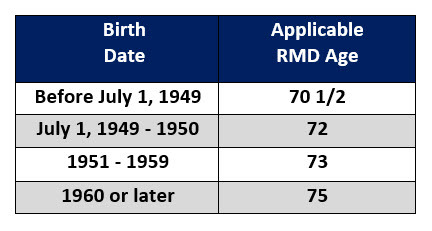New RMD Provisions: A Closer Look at What's Changing with SECURE 2.0
Part of a series | SECURE 2.0 Act Insights

The SECURE 2.0 Act continues to introduce new provisions that change the way plan sponsors and employees prepare for retirement. Find out how required minimum distribution rules are modified under the new law.
The SECURE 2.0 Act of 2022 was signed into law in December 2022. And it's already impacting employers and employees across the country.
The new provisions that are in effect — and those to be introduced over the next few years — are aimed to make employer-sponsored retirement plans more affordable, easier to manage and more accessible for everyone.
Among the benefits: Employees now have more time to grow their retirement plans before they need to start taking distributions. Here are three key ways in which required minimum distributions (RMDs) are changing under the new legislation.
RMD age extension
RMDs are the Internal Revenue Service's (IRS) way to ensure that retirees can't defer paying tax on the funds in their retirement accounts (e.g. traditional IRAs and 401(k) plans) indefinitely. Under the previous rule, once a retiree reached age 72, they were required to make mandatory withdrawals from their plan account each year.
Under SECURE 2.0, the age for RMDs was increased to 73 — offering employees an additional year to increase the savings in their tax-free retirement accounts and avoid a taxable distribution. Their first RMD must be taken by April 1 of the year they turn 73, and by December 31 each following year.
Then, starting in 2033, SECURE 2.0 again pushes the age at which RMDs must start to 75.

Reduced penalty
Under the old rules, if a retiree missed the RMD deadline, they would incur a penalty of 50% of the amount not taken on time. That penalty has been reduced in SECURE 2.0 to 25%, and in some cases, 10% if corrected within two years. The 50% was a harsh penalty for retirees and the lower penalties, especially if caught and fixed timely, are very welcome changes.
Pre-death requirement eliminated
Beginning in 2024, the pre-death requirement to take minimum distributions for Roth 401(k) accounts will be eliminated. This aligns with the treatment of RMDs for Roth IRA accounts, which don't require distributions during one's lifetime.
Getting up to speed
The SECURE 2.0 Act empowers more American workers to close the retirement savings gap. As a plan sponsor, employers should help make sure employees are up to date on the legislative changes that can benefit them down the road.
That's why ADP offers robust employee education for plan participants. From customized communications to interactive tools and resources, ADP helps you — and your employees — unlock your retirement plan's full potential. If your current plan isn't doing the same, reach out to learn more.
Get more information on this topic; launch this on-demand webinar anytime -- SECURE 2.0 Act of 2022: Changes & How It Impacts You.
Intended for Plan Sponsor Use Only
ADP, Inc., and its affiliates do not offer investment, tax, or legal advice to individuals. Nothing contained in this article is intended to be, nor should be construed as, particularized advice or a recommendation or suggestion that you take or not take a particular action. Questions about how laws, regulations, guidance, your plan's provisions, or services available to participants may apply to you should be directed to your plan administrator or legal, tax or financial advisor. ADPRS-20230220-4200



